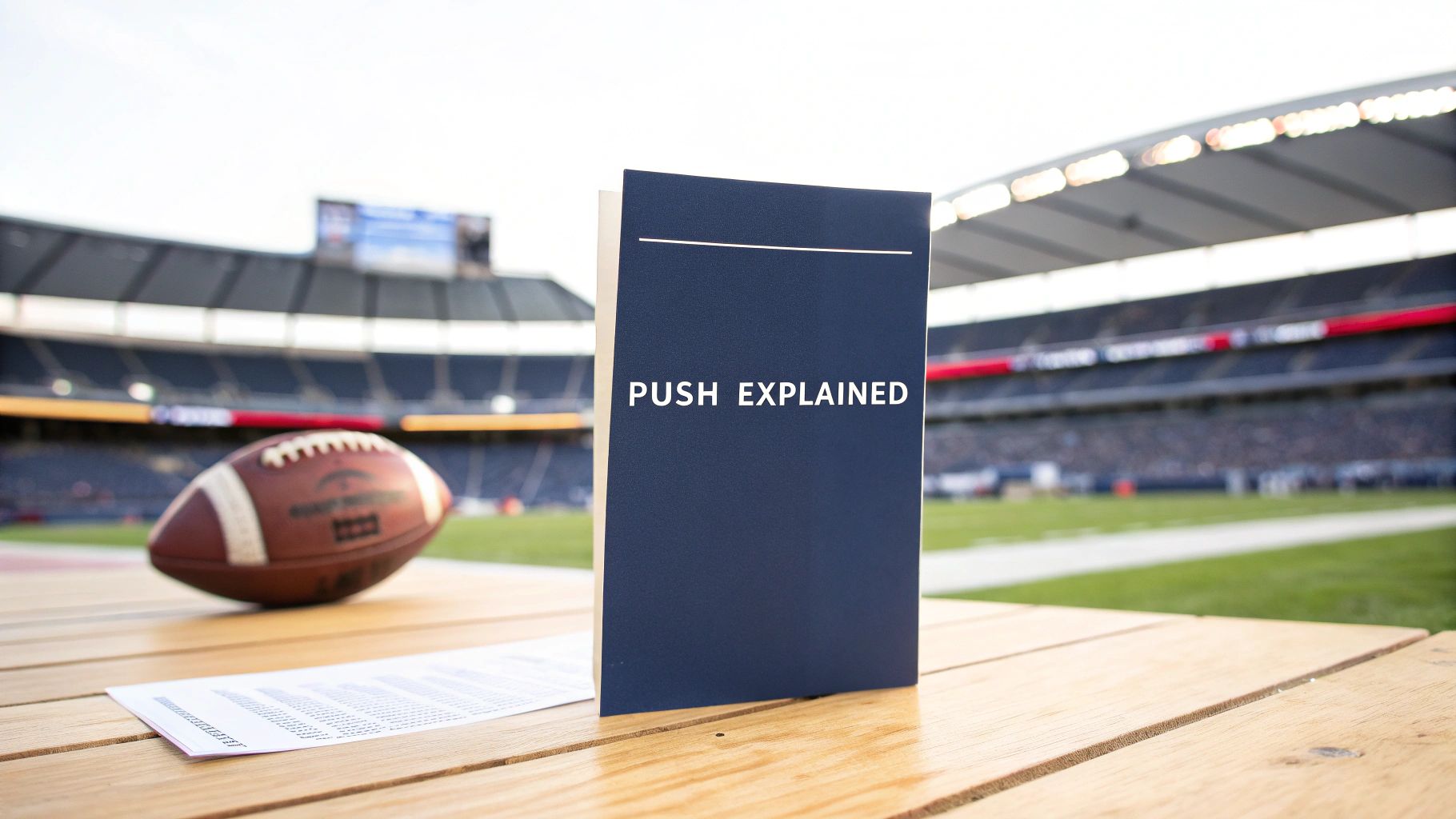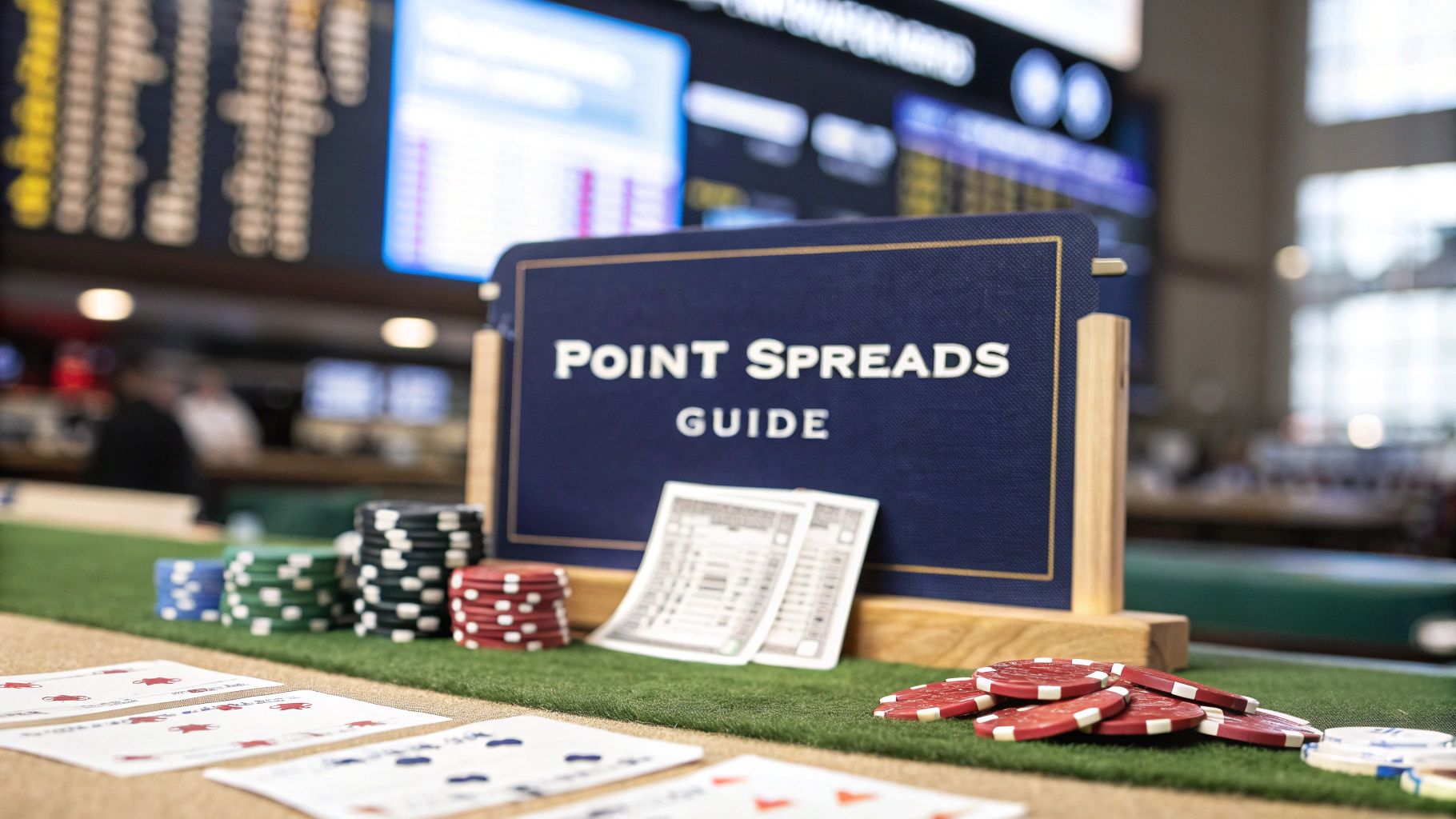
A Bettor's Guide to Points and Spreads
Master sports betting with our guide to points and spreads. Learn how they work, why they matter, and how to use them to make smarter bets today.
Picture this: a running race where one athlete gets a head start to even things out. That's the perfect way to think about a point spread in sports betting. Instead of simply picking a winner, you're betting on how much a team will win or lose by. This clever twist, using points and spreads, can turn even the most lopsided matchup into a nail-biter.
What Are Points and Spreads in Betting
At its heart, a point spread is a number oddsmakers create to level the playing field between two teams that aren't evenly matched. It’s essentially a handicap for the team expected to win (the favourite) and a boost for the team expected to lose (the underdog).
This simple mechanic completely changes the game. Your goal is no longer just to pick the outright winner. Instead, you need to predict how a team will perform against the bookmaker's expectations. It adds a fantastic layer of skill and strategy that pulls in everyone from first-time punters to seasoned pros.
The Favourite and the Underdog Explained
Getting to grips with the favourite and the underdog is your first step. It's a really straightforward concept, and it all comes down to the plus (+) and minus (-) signs you see next to the numbers.
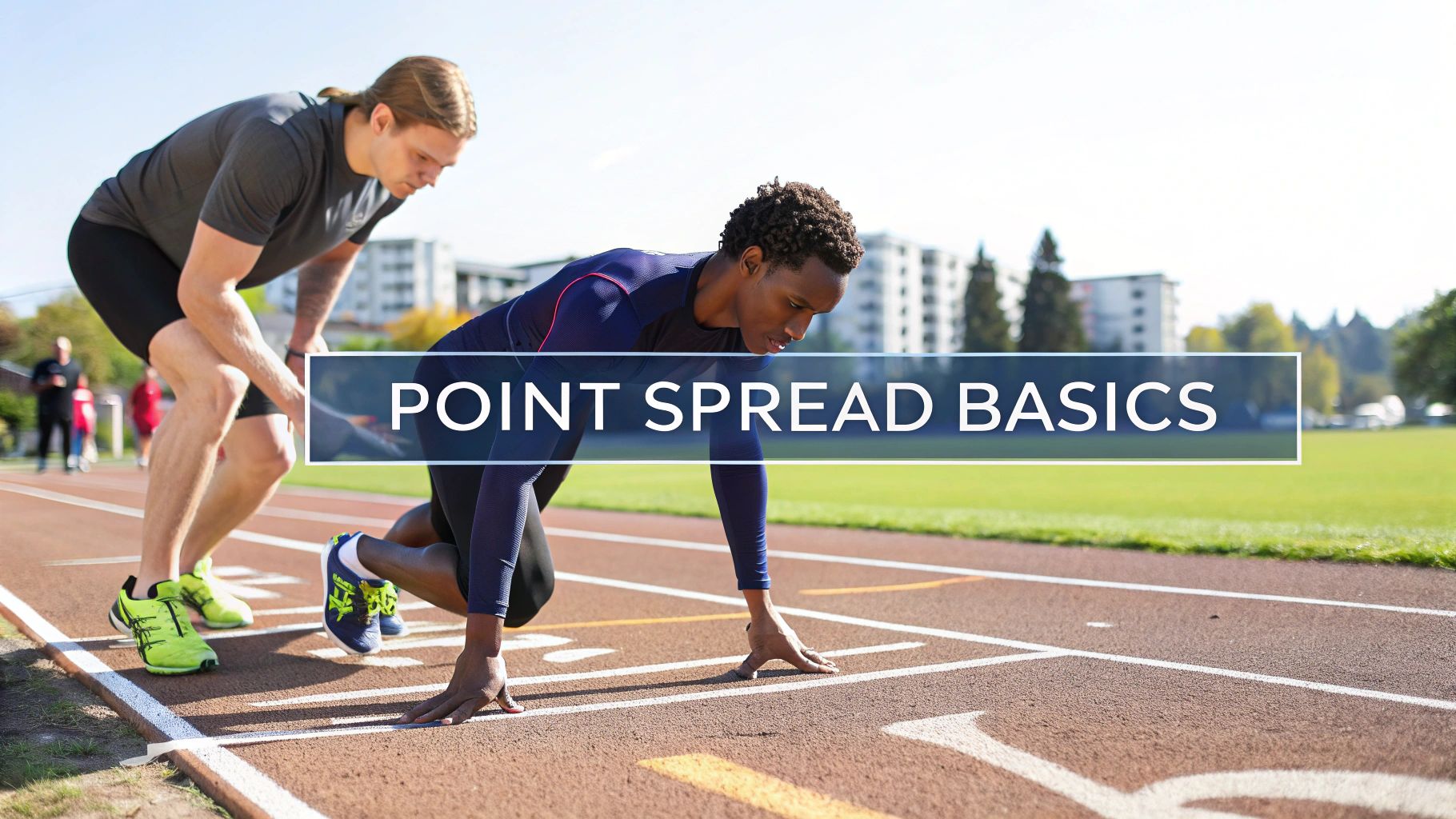
Here's how it breaks down for each side:
The Favourite: This is the team everyone expects to win, and you'll see a minus sign (like -7.5) next to their name. For a bet on them to pay out, they don't just have to win the game—they have to win by more points than the spread.
The Underdog: This is the longshot, marked with a plus sign (like +7.5). They have two ways to win you the bet: they can either pull off an upset and win the game outright, or they can simply lose by fewer points than the spread.
This balancing act is what makes spread betting so popular. In markets like Romania, for instance, point spreads are absolutely essential for betting on football and basketball. They inject excitement and create genuinely competitive betting opportunities in every single match.
For an even closer look at how this all works, our guide on the spread bet meaning breaks it down even further.
To quickly recap, here’s a simple table to show you what each team needs to do to "cover the spread" and win you the bet.
Favorite vs Underdog How to Win Your Bet
| Team Type | Spread Symbol | How They 'Cover the Spread' |
|---|---|---|
| Favourite | - (minus) | Win the game by more than the spread number. |
| Underdog | + (plus) | Win the game outright or lose by less than the spread. |
As you can see, the spread creates a clear mission for both teams from a betting perspective. It's not just about the final score, but how that score compares to the number set by the oddsmakers.
How Sportsbooks Set Points and Spreads
Ever wondered where those numbers for points and spreads actually come from? It’s a classic mistake to think the bookies are trying to nail the exact final score. The truth is, their real game is all about strategy. Their number one goal is to create a perfectly balanced market—one that gets roughly the same amount of money bet on the favourite as on the underdog.
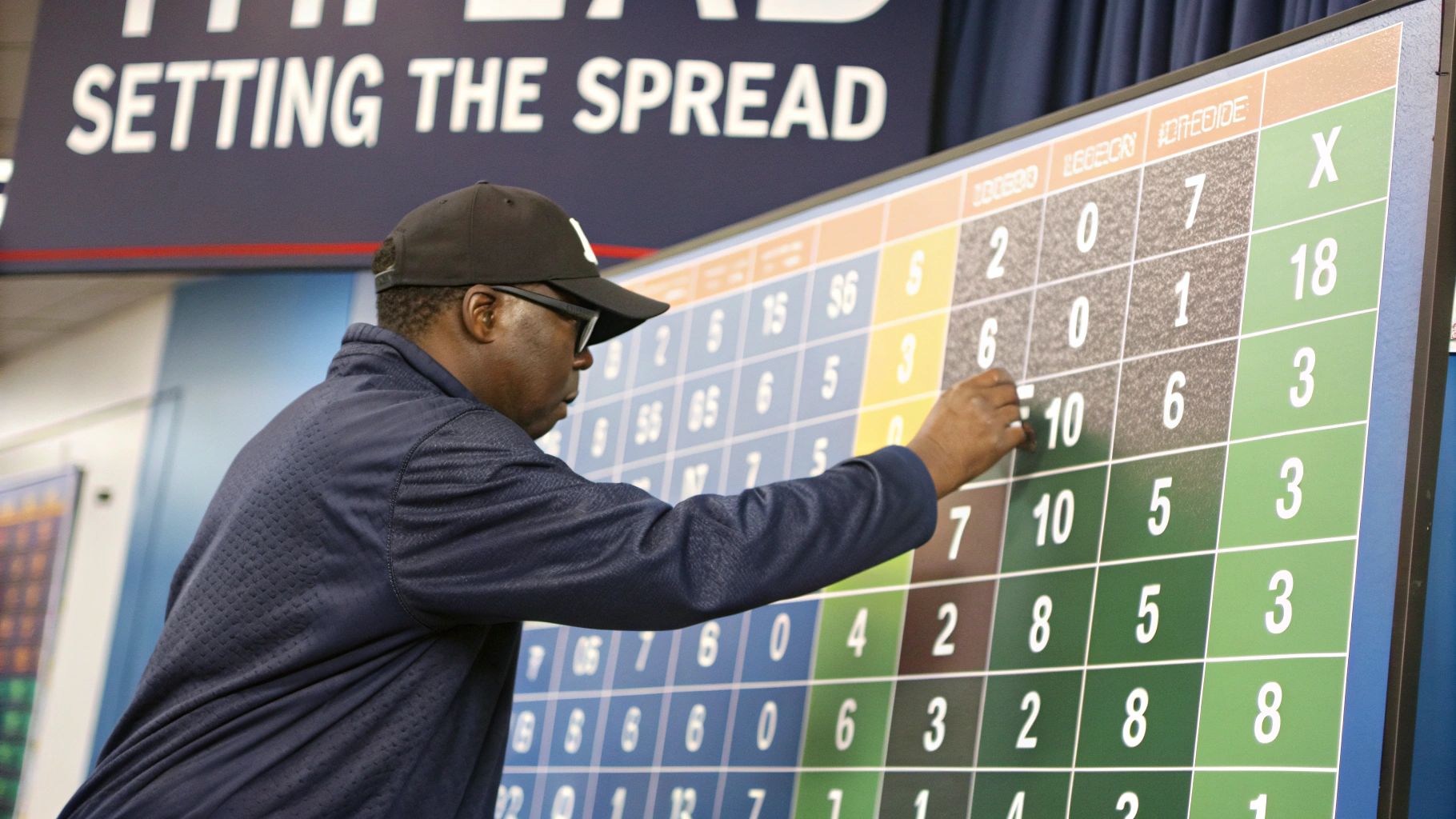
When they pull off this 50/50 split, the sportsbook locks in a profit. They don’t even care which team wins or covers the spread. Their earnings come from the commission, known as the "juice" or "vig," that they take on losing bets. That's the business model in a nutshell.
Crafting the Opening Line
That first spread you see, the "opening line," is where the magic really happens. It's a blend of high-tech science and old-school expertise. Oddsmakers don't just guess; they lean on powerful computer models and detailed power ratings that crunch a mountain of data.
Think about all the variables they have to consider:
- Historical Performance: What's the head-to-head history between these two teams?
- Recent Form: Is a team red-hot on a winning streak, or have they been in a slump?
- Key Player Status: Crucial injuries, suspensions, or a star player's return can completely change the game's outlook.
- Situational Factors: This is a catch-all for everything else, like travel fatigue from a long road trip, home-field advantage, and even the weather forecast.
All this data gets analysed to create a starting point. And these days, the process is getting even more sophisticated, as you can see in our breakdown of the multi-agent AI betting model that powers modern predictions.
A point spread is not a prediction; it is a market number. Its purpose is to divide public opinion and attract balanced action on both sides of the contest, ensuring profitability for the house.
But that initial number is just the beginning. Once it's out there, the spread starts to take on a life of its own.
Why Spreads Move After They Are Set
As soon as a line goes public, your bets—and everyone else's—start pushing it around. If a flood of "public money" comes in on one side, the sportsbook has to act. They’ll adjust the spread to make the other side look more appealing, hoping to lure some action back and rebalance their books. It's all about managing their financial risk.
Sometimes, outside forces can make a difference, too. For example, legislative changes like the recent Romanian gambling laws brought in higher taxes for operators. This kind of shift could force sportsbooks to tweak their points and spreads or odds slightly to protect their profit margins, which shows how even regulatory news can influence the numbers you see on your screen.
How to Read and Interpret Betting Lines
Seeing a line of numbers and symbols at a sportsbook can feel a bit like decoding a secret message. But once you know the language, you can size up a bet in seconds. It's all about turning that theory into practical action.
Let's walk through a classic example you'd see for a football match: Team A -7.5 (-110) vs. Team B +7.5 (-110).
This isn't just a random jumble. Every part of that line tells you a crucial piece of the story, from who's expected to win (and by how much) to what you'll pay for your wager.
Breaking Down the Numbers
First up, you have the point spread itself: -7.5 for Team A and +7.5 for Team B. This is the handicap we've been talking about. If you back Team A, they don't just have to win; they need to win by 8 points or more for your bet to cash. On the flip side, a bet on Team B wins if they either win the game outright or lose by 7 points or fewer.
This visual breaks down the three core components you'll find in almost any betting line.
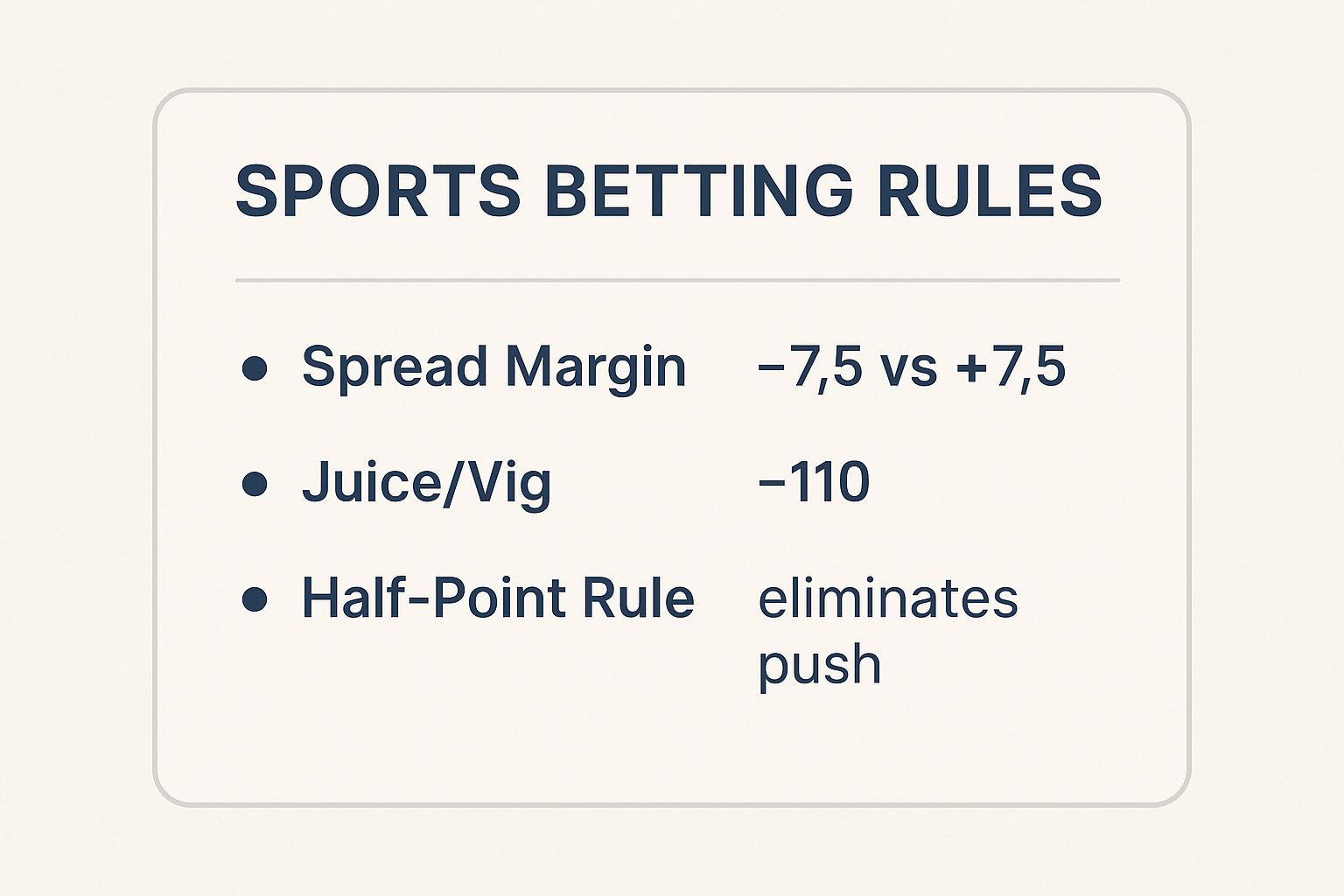
It’s a handy reference for how the spread, the odds, and that little half-point all work together to create a balanced bet.
Now, what about that number in the parentheses? The (-110) is what's known in the business as the "juice" or "vig"—essentially, the sportsbook's commission. It shows you the price of placing the bet. If you want a complete breakdown, our guide explains how to read betting odds in more detail. But in short, -110 means you have to bet €110 to win €100. This small fee is how the house makes its money.
The half-point (that .5) is one of the smartest little tricks in spread betting. It exists for one reason: to prevent a "push," or a tie. If the spread was just -7, a 7-point win would mean all bets are refunded. With -7.5, there's always a clear winner and a loser. No grey areas.
This clean, simple structure is precisely why spread betting is so popular. Every bet has a definite outcome, making it a straightforward way to get in on the action.
Comparing Spreads to Other Common Bet Types
So, you're getting a handle on the point spread. That's a massive step. But how does it actually stack up against the other bets you see plastered all over a sportsbook? It's one thing to know what a spread is, but it's another to know when to use it.
While spreads are all about the margin of victory, other popular wagers ask completely different questions. This is where you can start to get strategic.
The Straight-Up Winner: Moneyline
The most common alternative is the moneyline bet. It doesn't get any simpler than this: you’re just picking which team will win the game. Full stop. It doesn't matter if they win by 1 point or 50—as long as they come out on top, your bet cashes. It’s a pure prediction of who gets the victory.
The Game’s Flow: Totals (Over/Under)
Then you have the totals bet, which you'll often hear called the over/under. With this one, you couldn't care less about who wins or by how much. You're betting on whether the combined final score of both teams will go over or under a specific number set by the sportsbook. It's a bet on the pace and style of the game itself.
Spread vs Moneyline vs Totals: Picking Your Angle
Each of these bets gives you a different way to attack a game. The point spread is your go-to for making a lopsided matchup interesting. A moneyline is perfect when you have a gut feeling an underdog is going to pull off a shock upset. And totals? That's for when you're confident the game will be a high-scoring shootout or a low-scoring defensive battle.
The key is to match the bet type to your analysis. Choosing between a spread, moneyline, or total depends entirely on where you see the most value in a given matchup.
To put it all in perspective, here’s a quick breakdown of how these three core bets differ.
Spread vs Moneyline vs Totals: A Quick Comparison
Think of this table as your cheat sheet for deciding which bet best fits your game prediction.
| Bet Type | What You Are Betting On | Best For |
|---|---|---|
| Point Spread | The margin of victory between two teams. | Levelling the playing field in matchups with a clear favourite. |
| Moneyline | The outright winner of the game. | Backing an underdog to win or betting on a close, even contest. |
| Totals | The combined score of both teams. | When you predict a high-scoring or low-scoring game dynamic. |
Ultimately, understanding these three options is the foundation of any solid betting approach. They give you the flexibility to find an angle on almost any game, whether you're focused on the final score, the winner, or the overall pace of play.
Actionable Strategies for Betting on Spreads
Knowing what a point spread is is one thing. Actually using that knowledge to win money is a completely different ball game. This is where we move from theory to practice, and it’s about a lot more than just getting lucky. Winning at spread betting comes down to finding value, managing your risk, and making smart, disciplined choices based on solid research—not just a gut feeling.
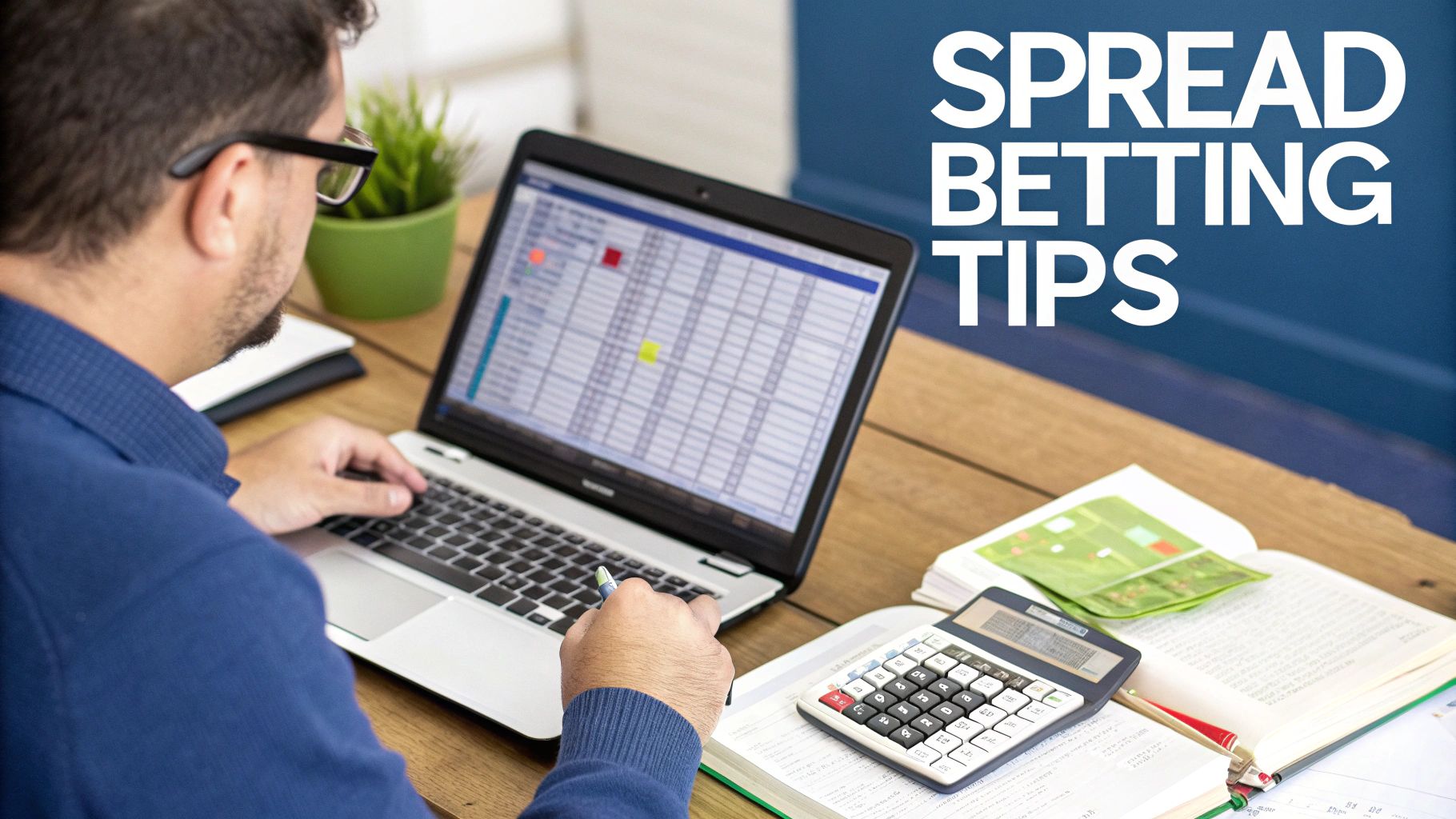
Let's get past the basics. It’s time to equip you with some real strategies to break down matchups, spot the best opportunities, and walk into the market with a confident game plan.
Fading the Public
One of the oldest tricks in the book is "fading the public." In simple terms, this means you bet against the team everyone else is piling money on. The reasoning here is pretty straightforward: sportsbooks need to balance their books. When a flood of casual bettors backs one team, the line inevitably moves to encourage action on the other side. This often creates a sweet spot of value for sharp bettors who can see past the hype.
The general public often bets with their heart, throwing money behind their favourite teams or getting swept up in media narratives. Taking a contrarian stance can be incredibly profitable because you’re capitalising on these emotional line shifts.
Understanding Key Numbers
In some sports, certain winning margins pop up far more often than others. We call these key numbers. They’re most critical in American football, where countless games are decided by 3 points (a field goal) or 7 points (a touchdown plus the extra point). This is huge. A spread of -2.5 is way more attractive than -3.5, because a simple 3-point victory covers the first but loses the second. You have to be mindful of whether the spread you’re betting has crossed one of these crucial numbers.
Essential Betting Principles
Beyond these specific tactics, it's the underlying discipline that truly separates the winners from the losers. To consistently make money betting spreads, you need a solid foundation.
- Bankroll Management: This is non-negotiable. Never bet more than you can comfortably afford to lose. A solid rule of thumb is to risk only 1-3% of your total bankroll on any single bet. It’s the best way to survive a losing streak and keep your emotions in check.
- Avoid Chasing Losses: We've all been there. After a tough loss, it’s so tempting to place a big, reckless bet to try and win it all back. Don’t do it. That’s the fastest way to drain your account. Stick to your plan.
- Do Your Research: Don't bet on a team just because of their name. Dig into their recent form, check the injury report, and analyse the specific matchups. Find an angle that the public might be missing.
The explosion of online sports betting has made these markets easier to access than ever. In Romania, for example, online gambling revenue soared to around €284 million in 2021, which shows just how mainstream it’s become. You can find more details on the Romanian gambling market on Statista. With so much action out there, having a sound strategy for betting on points and spreads isn't just an advantage—it's essential.
Got Questions About Spreads? Let's Clear Things Up
Alright, we've covered the basics, but it's the little "what if" scenarios that often trip people up. Let's tackle some of the most common questions that pop up when you're starting out with point spread betting. Think of this as your go-to cheat sheet.
We'll run through a few key situations you're bound to encounter, making sure you feel ready to place that first spread bet with confidence.
What Happens If a Game Ends in a Push?
Ah, the dreaded "push." This is what happens when the final score lands exactly on the spread. For example, if the New England Patriots are a -7 favourite and they win by exactly seven points, it’s a push.
When this happens, the bet is basically a wash. The sportsbook refunds your stake in full—you don't win any money, but you don't lose any either. This is precisely why you'll often see spreads with a half-point (-7.5), as it makes a push impossible and guarantees a winner and a loser.
Can I Bet on Spreads in Sports Other Than Football?
You bet. While football and basketball are the kings of the point spread, the concept is used across plenty of other sports to even things up. The name might change, but the core idea of giving one team a handicap remains the same.
- In hockey, they call it the "puck line." This is almost always set at -1.5 goals.
- In baseball, you'll hear it referred to as the "run line," which is also typically -1.5 runs.
Is It Better to Bet the Favourite or the Underdog?
This is the million-dollar question, but the answer isn't so simple. There's no magic formula for picking one side over the other. Remember, the sportsbook's job is to create a line that attracts an equal amount of money on both sides—a perfect 50/50 split.
The real skill in spread betting isn’t about blindly backing favourites or always looking for an upset. It’s about finding value. You’re looking for spots where you believe the oddsmaker got the line wrong, giving one team a better chance to cover than the odds suggest. That value can pop up on either side of the bet.
Stop leaving your betting decisions to chance. OddsHaven uses AI to analyse dozens of football leagues, delivering daily high-confidence picks and parlay suggestions backed by data, not gut feelings. Get the insights you need to bet smarter at https://www.oddshaven.ai.
Ready to Start Winning?
Join OddsHaven and get instant access to AI-powered predictions with an 87% win rate on high-confidence picks
Try OddsHaven Free for 5 Days
